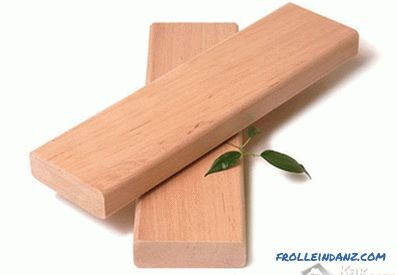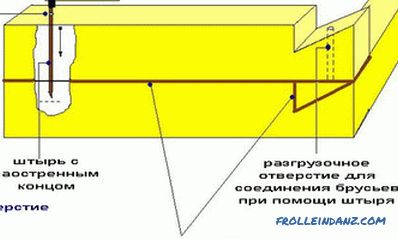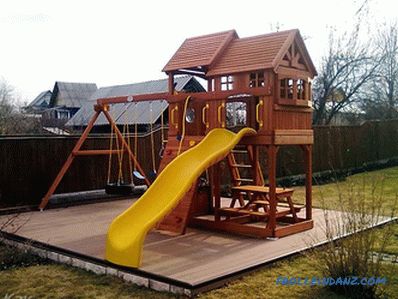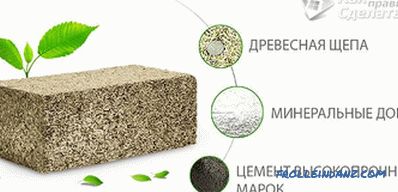Ceramic bricks are widely used for the construction of heating furnaces in individual residential buildings. The construction industry produces a wide range of bricks for the furnace masonry, but which one to choose from the proposed nomenclature? Before we consider this question, you need to understand the fact that two types of brick are used for laying the furnace - it is a simple ceramic brick, but with certain characteristics, which is used for laying the external elements of the furnace, chimneys and fire-resistant or chamotte brick, which is used for masonry stove furnace.
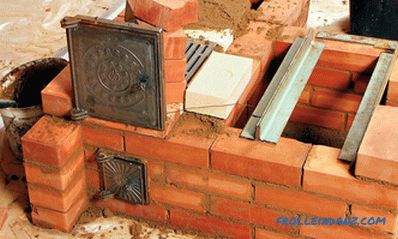
What properties should the brick have to possess when used for masonry of the furnace
The furnace brick must meet the following technical requirements:
- Resistant to high temperatures and open flame.
- Ability to accumulate heat and retain it for a long time.
- Sufficient mechanical strength.
- Resistance to significant temperature fluctuations.
Solid fuel furnaces are built of ceramic bricks that meet the requirements of GOST 390-96. This standard was put into effect on July 1, 1997 and establishes the technical conditions with which these products must conform in form and size. The regulatory document also defines the requirements for the use of products, depending on the maximum ambient temperature.
Ceramic bricks intended for the construction of thermal units are subject to more stringent requirements than other building materials. In the furnace of the furnace, the flame temperature can exceed 1000 ° C, respectively, its walls are subjected to significant thermal loads. Thermophysical parameters of the material used must be higher than the specified value.
During operation of the furnaces, they are regularly cooled in individual cases and to negative temperatures. In this case, a brick undergoes a significant difference in ambient temperatures, which leads to thermal expansion and subsequent compression. The product must have a sufficient margin of safety in order to successfully resist this phenomenon and avoid deformation and destruction.
A brick used for laying furnaces must have a sufficiently high thermal conductivity and the ability to accumulate heat. The first property is necessary for the rapid heating of the room and the transfer of energy of burned fuel to the external environment. The second quality allows you to maintain this process after the cessation of combustion in the furnace for a long time. This allows you to maintain a comfortable thermal regime for a long time.
The use of different types of bricks for laying different furnace elements
Solid-fuel furnaces have a rather complex structure, the components of which work under certain conditions. The question arises, what brick is needed for the laying of the furnace and its elements?
The design of the heating furnace is as follows:
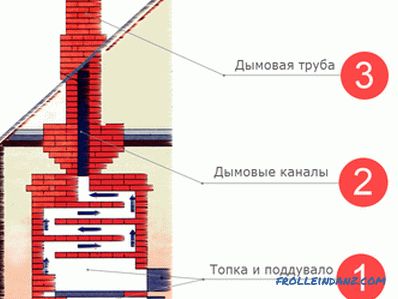
1. The firebox and the blower.
The combustion chamber mainly has two-layer walls, the internal one is made of refractory (fireclay) bricks, the external one is made of facing ceramic bricks. The furnace is made of fireclay bricks with maximum refractory properties. The exterior of the kiln works in less stressful conditions and it is possible to use facing bricks with excellent decorative characteristics.
2. Smoke channels.
Smoke ducts are a large heat exchanger and the temperature in them, although lower than in the furnace, is still quite high. Chamotte brick is used for laying the furnace elements. Outside, the structure may be faced with ceramic tiles or facing bricks.
3. Chimney.
The chimney is in direct contact with the atmosphere and experiences large temperature differences. Therefore, it uses ceramic bricks with the highest possible resistance to frost. Usually this element also has a two-layer structure with a decorative exterior finish of ceramic brick or metal box.
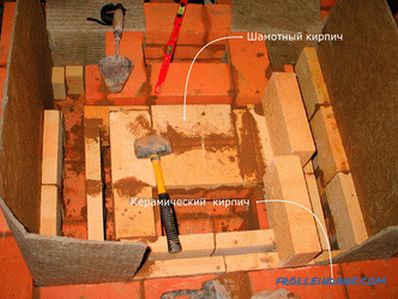
The process of laying the kiln and the example of using chamotte bricks to build heavily loaded elements and the most recent lining of ceramic bricks.
The use of bricks with appropriate characteristics for the arrangement of individual furnace elements will ensure maximum durability and excellent thermal and physical properties. Experienced stove makers pay particular attention to this issue when selecting material. At the same time, a thorough examination and rejection of bricks with large cracks and deep damage and chipping is made.
What characteristics should a ceramic brick have for laying a kiln and chamotte brick for laying firebox
Characteristics of a ceramic brick for laying external elements of a furnace, smoke channels and pipes
As we have already said Previously, a certain type of ceramic brick is being laid on the stove, now we will look at the main characteristics of this brick.
Brand by density. The first thing you need to look at when choosing a ceramic brick for a furnace is the brand in density. The brand of ceramic brick density is set in accordance with the requirements of GOST 530-2012. For its designation, an alphanumeric encoding is used, consisting of the letter "M" and a number from 25 to 1000. Note that this indicator does not indicate the quality of the brick, but only shows its density when pressed. This indicator is important because the denser the brick, the slower it heats up, and therefore cools more slowly. The fact that the brick will slowly cool is nice, since the stove will give off heat for a longer time. But it is more difficult to heat a furnace made of too dense brick, especially when it has completely cooled down. Here the balance is important, therefore brick is used for brick laying with a density not lower than M-150 and not higher than M-250.
Frost resistance. The frost resistance of a product is defined as the ability to withstand a certain number of heating and cooling cycles. This indicator is denoted by the Latin letter F with the addition of the number from 25 to 300. The cold resistance index of ceramic bricks is important when erecting external elements of a heating furnace, such as chimneys. The thing is that this integral part of the furnace is in very harsh conditions of constant temperature difference. This has a huge impact on the brick used for laying the pipe. For the construction of such structures is best to use ceramic bricks with frost resistance from F75 to F100.
Thermal Conductivity. The thermal conductivity of a ceramic brick will depend on its density and for the products used for the laying of the furnace it should be in the range from 0.59 to 0.72 W / (m * ° C).
Full Body. Only solid ceramic bricks are used for the masonry of the furnace.
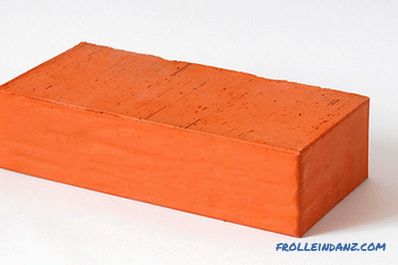
Ceramic kiln brick.
Chamotte bricks with the following characteristics are used for the masonry of the combustion chamber of the furnaces
- Product brand: ShAK, PB, ShA, ShB, PV, ShV and ShUS.
- The softening temperature is not lower than 1300 ° C.
- Uniformity of blocks throughout the volume.
- High density and low porosity of products.
The operational characteristics of the furnace and the duration of its intended use are directly dependent on the quality of the refractory bricks of which the furnace is built.
The building materials market offers an extensive range of products suitable for laying fireboxes. The question arises, from which brick is it better to fold the furnace so that it is durable and retains its properties for a long time. Experts recommend the use of refractory fireclay semi-acid brick. These products have the best combination of cost and thermal characteristics and quality.
The main technical characteristics of the ceramic brick used for the construction of solid-fuel furnaces are summarized in the table:
| Indicators | Normal indicators for the brands | ||||||
|---|---|---|---|---|---|---|---|
| SHAK | ША | ШБ | ШВ | ШУС | PB | PV | |
| Fire resistance, ° C | 1730 | 1600 | 1650 | 1630 | 1580 | 1657 | 1580 |
| Porosity,% not higher than | 23 | 24 | 24 | 24 | 30 | 24 | 25 |
| The ultimate strength of the product, N / mm2 | 23 | 20 | - | 20 | 12 | 20 | 1 3 |
| The temperature of the beginning of softening, ° C | 1320 | 1300 |

Fireclay bricks.
Choice of the manufacturer of furnace brick
The market for this type of building materials is extremely saturated with products of domestic and foreign companies. In this segment, products made by enterprises from Russia, Belarus and the Baltic republics are widely represented.
Vitebsk Brick Works Shop No. 1.
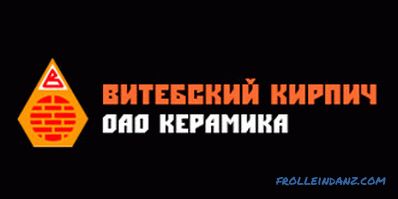
Ceramic bricks of this manufacturer meet the requirements for the material for furnaces by density grade. Product frost resistance is extremely low. Brand density 180 - 200. The brick can be used for lining the furnace and chimney channels, for other elements it is unsuitable.We can say that this is one of the most common, today, materials for the construction of the furnace. It cannot be used for laying the furnace and the first chimney of the furnace. It is required to produce the lining of the firebox and the first chimney with fire-resistant fireclay bricks.
With constant direct contact with fire, this brick quickly collapses. Since the products have low frost resistance, the use of this brick for laying the external walls of the chimney street pipe is also excluded. The advantages of this material include the fact that this is one of the most budgetary options and given all the nuances it is quite possible to use it for the laying of the furnace. It has 2 work surfaces. In general, the quality of this brick can be described as satisfactory.
LODE.
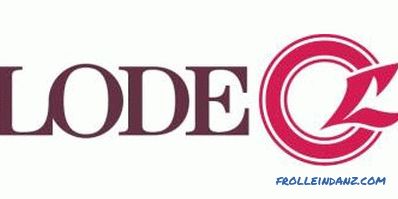
LODE bricks are made in the Baltic States. Ceramic brick has a high grade in density - 500 and frost resistance. The product is used for lining the external surfaces of the furnace and chimney. The brick of this brand has various forms and is often used to create all kinds of decorative elements of the furnace. According to its main purpose it is facing brick.
Borovichsky brick factory.

Products of Borovichsky brick factory located in the Novgorod region. Mass production started in 2011, experts assess its quality as good. Mark density of ceramic bricks M-250, cold resistance indicators at F25. There are significant deviations of products from the size, established standards, up to 10 - 12 mm in one batch. This should be taken into account when laying the furnace and it is best to take a little more brick than necessary. Further, it all depends on the professionalism of the stove maker and his ability to select the right products. The brick has rounded upper and lower edges and 3 working surfaces.
Refractory or fireclay bricks of Russian production.
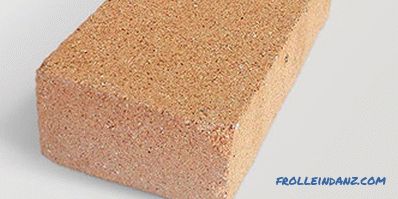
The quality of products varies greatly, from a frank marriage to quite decent products. Fireclay brick has a smooth cream color and high density, the shape is correct with right angles. As we found out earlier, this brick is necessary for the lining of the combustion chamber of classic stoves, fireplaces and fireplaces. But to select certain manufacturers here is quite difficult.
The answer to the question which brick is best for the furnace is usually decided by the customer in consultation with the master. It takes into account several factors, among which the main ones are compliance with the requirements of standards and cost. The operational properties of the structure depend on the correctness of the choice of refractory wirpices; saving at the expense of quality is expensive.
Methods for determining the quality of furnace brick
Verification of compliance of this type of building materials with the requirements of regulatory documents is carried out according to the procedures approved by the Gostov series. Each of them is designed to determine the individual characteristics of the refractory brick:
- GOST 5402. 1-2000. Method for determining residual deformations after heating.
- GOST 4069-69. The control method of refractoriness of products.
- GOST 151136-78. Methods for measuring damage to corners and edges of ceramic blocks.
Brick tests are carried out in laboratories using special equipment. At home, it is impossible to check the quality of refractory bricks using the methods described in the standards. The buyer has to rely on the certificates and qualifications of the master, which is desirable to bring to the decision of the choice of material for the construction of the furnace.
Experienced stoves are able in many cases to determine the quality of refractory bricks by some signs. Furnaces are constructed only from solid ceramic bricks with a mark from M150 to M250. In this case, the certificate must contain a record stating that the specified product is intended for this type of work.
The following methods are used to determine the properties of a brick:
Vibration and sound. A large side of a brick that is held down by a small blow with a hammer is applied. The tool should bounce off the surface with a jingle. This indicates the absence of internal cracks.
Examination of the appearance. A brick must have a regular shape with a maximum deviation from the standard size within 2 mm in one or the other side.
Internal structure. Evaluated by the condition of the cleavage, while the color of the section should be uniform over the entire area. The presence of stains indicates the presence of stress areas in the brick massif, which may cause its destruction during heating. Chamotte chipping should not occur from the internal structure of the material.
Using the above methods for assessing the quality of refractory ceramic bricks for building in a furnace will allow you to select the material necessary for this. The use of building bricks complying with the requirements of GOST will provide the heat engineering unit with an appropriate level of strength and reliability.

